-
Countries
-
Data and Analysis
-
Special Focus
-
Crisis Responses
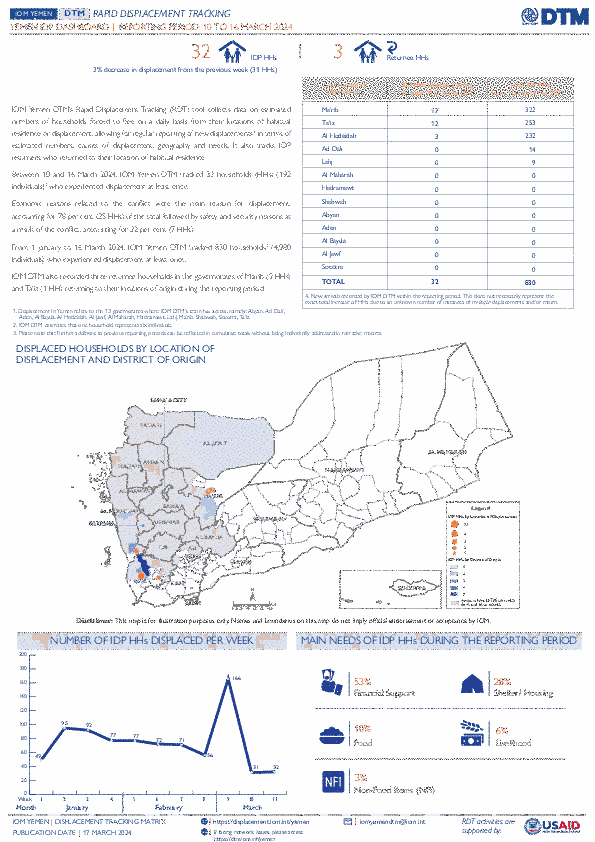
Contact
DTM Yemen, iomyemendtm@iom.int
Language
English
Location
Yemen
Period Covered
Mar 10 2024
Mar 16 2024
Activity
- Mobility Tracking
- Event Tracking
IOM Yemen DTM’s Rapid Displacement Tracking (RDT) tool collects data on estimated numbers of households forced to flee on a daily basis from their locations of origin or displacement, allowing for regular reporting of new displacements in terms of estimated numbers, geography, and needs. It also tracks returnees who returned to their location of origin.
From 1 January to 16 March 2024, IOM Yemen DTM tracked 830 households (HH) (4,980 Individuals) who experienced displacement at least once.
Between 10 and 16 March 2024, IOM Yemen DTM tracked 32 households (192 individuals) displaced at least once. The majority of people moved into/within the following governorates and districts:
- Ma’rib (17 HHs) – Ma’rib City (9 HHs), Ma’rib (8 HHs) districts. Most displacements in the governorate originated from Ma’rib and Al Hodeidah.
- Ta’iz (12 HHs) – Mawza (11 HH), Al Mawasit (1 HH) districts. Most displacements in the governorate were internal.
- Al Hodeidah (3 HHs) – Hays (3 HHs) district. All displacements in the governorate were internal.
The majority of people moved from the following governorates and districts:
- Ta’iz (12 HHs) – Maqbanah (7 HHs), Mawza (3 HHs), Mashrah Wa Hadnan (1 HH) districts.
- Al Hodeidah (7 HHs) – Al Jarrahi (3 HHs), Al Marawiah (2 HHs), Al Hawak (1 HH) districts.
- Ma’rib (4 HHs) – Al Jubah (2 HHs), Harib (2 HHs) districts.
IOM identified 16 households displaced in the previous reporting period, which covered 03 - 09 March 2024, in the governorates of Al Hodeidah (11 HH), Ma’rib (4 HHs), and Ta’iz (1 HH). These figures have been added to the cumulative displacement total recorded since the beginning of the year.
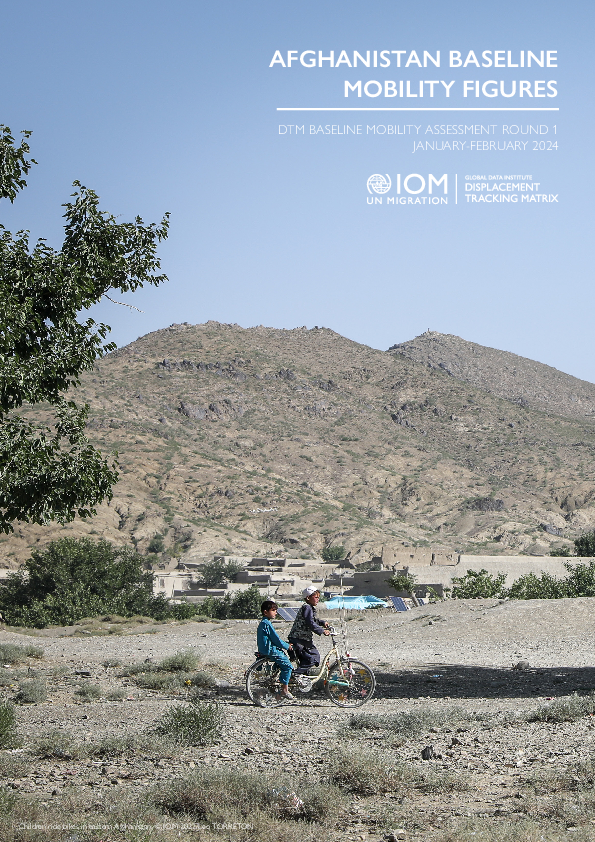
Contact
DTMAfghanistan@iom.int
Language
English
Location
Afghanistan
Period Covered
Jan 25 2024
Feb 29 2024
Activity
- Mobility Tracking
- Baseline Assessment
IOM Afghanistan launched the first round of the DTM Baseline Area Assessment B1 in January 2024 as part of its ongoing efforts to collect crucial data on population mobility dynamics, specifically displacement and returns. In particular, the B1 activity seeks to map the presence of mobile population groups, such as Internally Displaced Persons (IDPs), returnees, and internal migrants, to enable further understanding of conditions, vulnerabilities, and humanitarian needs through targeted data collection and analysis. After implementation of the B1, a subsequent assessment, the Baseline Village Assessment B2, will target all locations that report presence of mobile population groups to verify the results of the B1 and collect more granular information on reasons for mobility, shelter types, and places of origin.
The following report covers data collected for the B1 in January and February 2024, during which the IOM DTM Afghanistan team was able to completely cover two thirds (23 out of 34) of the provinces in the country. Further data collection to cover the remaining provinces is anticipated in the coming days. For a provisional look at baseline mobility figures for all 34 provinces, see the annex on pages 9 and 10, which combines the current B1 data with data collected during previous DTM activities.
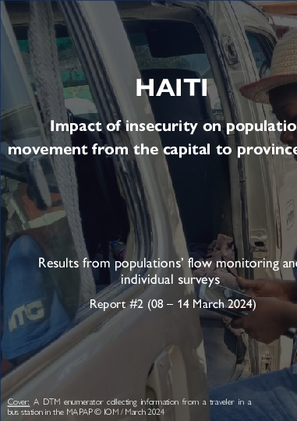
Contact
DTM Haiti, dtmhaiti@iom.int
Language
English
Location
Haiti
Period Covered
Mar 08 2024
Mar 14 2024
Activity
- Survey
- Flow Monitoring Survey
- Flow Monitoring
Since 29 February 2024, several neighborhoods in the Metropolitan Area of Port-au-Prince (MAPAP), the capital of Haiti, have been targeted by increased armed attacks. Nearly 15,000 people were displaced following these attacks (see ETT 39.1). In addition to creating displacement within the MAPAP, attacks and generalized insecurity are pushing more and more people to leave the capital to find refuge in provinces, taking the risks of passing through gangs-controlled routes. In order to monitor these movements towards provinces and inform appropriate response strategies, DTM has launched data collection at several of the most used bus stations in the capital (see page 5 for more details on the methodology). Since the start of this activity, on 8 March, until 14 March, this activity allowed to observe the movements of 16,947 people leaving the MAPAP (see pages 3 and 4 for more details on the profile of these people ). The majority of them (60%) took means of transport heading towards the Grand Sud departments (Grande’Anse, South, Nippes and South-East). It should be noted that this region already hosts more than 116,000 people who had in vast majority, fled the MAPAP in recent months (see the report on displacement in the Grand Sud).
Individual interviews with a sample indicated that 83% of people left the MAPAP because of violence and insecurity. 76% were already internally displaced before leaving the MAPAP. 96% intend to stay in the provinces in Haiti, 3% to leave for the Dominican Republic and less than 1% for the United States and Brazil.
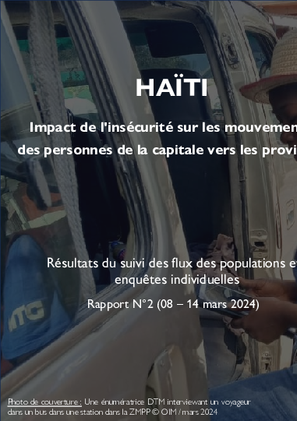
Contact
DTM Haiti, dtmhaiti@iom.int
Language
French
Location
Haiti
Period Covered
Mar 08 2024
Mar 14 2024
Activity
- Survey
- Flow Monitoring Survey
- Flow Monitoring
Depuis le 29 février 2024, plusieurs quartiers de la Zone Métropolitaine de Port-au-Prince (ZMPP), la capitale d’Haïti, sont ciblés par des attaques armées accrues. Près de 15 000 personnes se sont déplacées suite à ces attaques (voir le ETT 39.1). En plus de créer des déplacements à l’intérieur de la ZMPP, ces attaques poussent de plus en plus de personnes à quitter la capitale pour trouver refuge dans les provinces, en prenant les risques de passer par des routes contrôlées par des gangs. Afin de suivre ces mouvements vers les provinces et informer les stratégies de réponse adéquates, la DTM a lancé des collectes de données au niveau de plusieurs stations de bus les plus utilisées dans la capitale (voir la page 4 pour plus de détails sur la méthodologie). Depuis le début de cette activité, le 08 mars, jusqu’au 14 mars, cette activité a permis d’observer les mouvements de16 947 personnes quittant la ZMPP (voir les pages 3 et 4 pour plus de détails sur le profil de ces personnes). Ces personnes ont en majorité (60%) pris des moyens de transport se dirigeant vers les départements du Grand Sud (Grande’Anse, Sud, Nippes et Sud-Est). Il est à souligner que cette région accueille déjà plus 116 000 personnes qui avaient en grande partie fui la ZMPP durant des mois passés (voir le rapport sur les déplacements dans le Grand Sud).
Les interviews individuelles avec un échantillon ont indiqué que 83% des personnes quittaient la ZMPP à cause des violences et l'insécurité. 76% étaient déjà déplacées internes avant de quitter la ZMPP. 96% ont l'intention de rester dans les provinces en Haïti, 3% de partir vers la République Dominicaine et moins de 1% vers les Etats-Unis et le Brésil
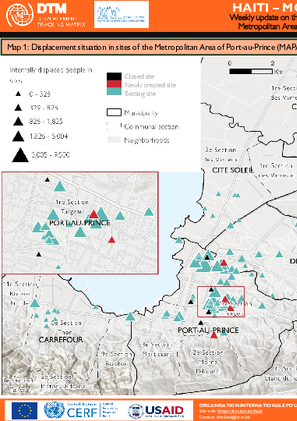
Contact
DTM Haiti, dtmhaiti@iom.int
Language
English
Location
Haiti
Period Covered
Mar 09 2024
Mar 15 2024
Activity
- Mobility Tracking
- Site Assessment
- Baseline Assessment
To continually inform humanitarian responses in the MAPAP sites, the CCCM cluster and DTM conduct weekly data collections in these sites to update information on the displacement situation in the sites.
This report presents the situation as of 15 March 2024. A total of 84 sites are active in the MAPAP hosting 86,040 IDPs, this represents 12% less compared to the previous week.

Contact
DTMMozambique@iom.int
Language
English
Location
Mozambique
Period Covered
Mar 15 2024
Mar 15 2024
Activity
- Mobility Tracking
- Event Tracking
Mozambique’s National Institute for Disaster Management (INGD) estimates more than 525,000 people to be affected by the landfall of Tropical Storm Filipo directly impacting communities of Inhambane, Gaza, Sofala and Maputo from 14 March. As of 14 March 2024, available reports indicate 208 individuals (54 families) still present in 2 accommodation centres (ACs) in Inhambane. Escola 3 de Fevereiro de Malaia and Centro de transito de Machocomane schools in Morrumbele and Vilankulo respectively have been deactivated following the return of families to places of usual residence. Shelter and non-food items have been reported as the top most priority needs among all accommodation centres. Other reported priority needs include Agriculture and Food security, healthcare and access to markets. Preliminary updates from ongoing joint assessments estimates 48,122 individuals (8,490 families) affected in 30 locations across Inhambane, Gaza, Sofala and Maputo provinces. As rain and flood events develop, ongoing joint assessments with INGD and humanitarian partners monitor the needs and conditions of affected populations in the region.
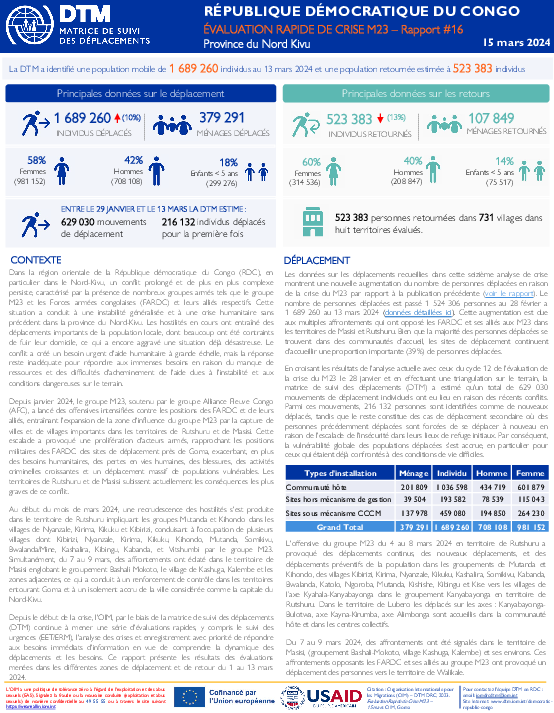
Contact
DTM DRC, iomdrcdtm@iom.int
Language
French
Location
Democratic Republic of the Congo
Period Covered
Mar 01 2024
Mar 13 2024
Activity
- Mobility Tracking
- Event Tracking
Dans la région orientale de la République démocratique du Congo (RDC), en particulier dans le Nord-Kivu, un conflit prolongé et de plus en plus complexe persiste, caractérisé par la présence de nombreux groupes armés tels que le groupe M23 et les Forces armées congolaises (FARDC) et leurs alliés respectifs. Cette situation a conduit à une instabilité généralisée et à une crise humanitaire sans précédent dans la province du Nord-Kivu. Les hostilités en cours ont entraîné des déplacements importants de la population locale, dont beaucoup ont été contraints de fuir leur domicile, ce qui a encore aggravé une situation déjà désastreuse. Le conflit a créé un besoin urgent d'aide humanitaire à grande échelle, mais la réponse reste inadéquate pour répondre aux immenses besoins en raison du manque de ressources et des difficultés d'acheminement de l'aide dues à l'instabilité et aux conditions dangereuses sur le terrain.
Depuis janvier 2024, le groupe M23, soutenu par le groupe Alliance Fleuve Congo (AFC), a lancé des offensives intensifiées contre les positions des FARDC et de leurs alliés, entraînant l'expansion de la zone d'influence du groupe M23 par la capture de villes et de villages importants dans les territoires de Rutshuru et de Masisi. Cette escalade a provoqué une prolifération d'acteurs armés, rapprochant les positions militaires des FARDC des sites de déplacement près de Goma, exacerbant, en plus des besoins humanitaires, des pertes en vies humaines, des blessures, des activités criminelles croissantes et un déplacement massif de populations vulnérables. Les territoires de Rutshuru et de Masisi subissent actuellement les conséquences les plus graves de ce conflit.
Au début du mois de mars 2024, une recrudescence des hostilités s'est produite dans le territoire de Rutshuru impliquant les groupes Mutanda et Kihondo dans les villages de Nyanzale, Kirima, Kikuku et Kibirizi, conduisant à l'occupation de plusieurs villages dont Kibirizi, Nyanzale, Kirima, Kikuku, Kihondo, Mutanda, Somikivu, Bwalanda/Mine, Kashalira, Kibingu, Kabanda, et Vitshumbi par le groupe M23. Simultanément, du 7 au 9 mars, des affrontements ont éclaté dans le territoire de Masisi englobant le groupement Bashali Mokoto, le village de Kashuga, Kalembe et les zones adjacentes, ce qui a conduit à un renforcement de contrôle dans les territoires entourant Goma et à un isolement accru de la ville considérée comme la capitale du Nord-Kivu.
Depuis le début de la crise, l'OIM, par le biais de la matrice de suivi des déplacements (DTM) continue à mener une série d'évaluations rapides, y compris le suivi des urgences (EET/ERM), l'analyse des crises et enregistrement avec priorité de répondre aux besoins immédiats d'information en vue de comprendre la dynamique des déplacements et les besoins.
Ce rapport présente les résultats des évaluations menées dans les différentes zones de déplacement et de retour du 1 au 13 mars 2024.

Contact
DTM DRC, iomdrcdtm@iom.int
Language
English
Location
Democratic Republic of the Congo
Period Covered
Mar 01 2024
Mar 13 2024
Activity
- Mobility Tracking
- Event Tracking
In the eastern region of the Democratic Republic of Congo (DRC), particularly in North Kivu, a prolonged and increasingly complex conflict persists, characterized by the presence of numerous armed actors such as the M23 group and the Congolese Armed Forces (FARDC) and their respective allies. This situation has led to widespread instability and an unprecedented humanitarian crisis in North Kivu province. The ongoing hostilities have led to significant displacement of the local population, many of whom have been forced to flee their homes, further exacerbating an already dire situation. The conflict has created an urgent need for large-scale humanitarian aid, but the response remains inadequate to meet the immense needs due to a lack of resources and difficulties in delivering aid due to instability and dangerous conditions on the ground.
Since January 2024, the M23 group, supported by the Alliance Fleuve Congo (AFC) group, has launched intensified attacks against positions belonging to the FARDC and their allies, resulting in the expansion of the M23 group's zone of influence through the capture of major towns and villages in the Rutshuru and Masisi territories. This escalation has led to a proliferation of armed individuals, bringing FARDC military positions closer to displacement sites near Goma, exacerbating, in addition to humanitarian needs, loss of life, injuries, growing criminal activity and massive displacement of vulnerable populations. The territories of Rutshuru and Masisi are currently suffering the most serious consequences of this conflict.
In early March 2024, renewed hostilities broke out in Rutshuru territory involving the Mutanda and Kihondo groups in the villages of Nyanzale, Kirima, Kikuku and Kibirizi, leading to the occupation of several villages including Kibirizi, Nyanzale, Kirima, Kikuku, Kihondo, Mutanda, Somikivu, Bwalanda/Mine, Kashalira, Kibingu, Kabanda, and Vitshumbi by the M23 armed group. Simultaneously, from March 7 to 9, clashes broke out in Masisi territory encompassing the Bashali Mokoto groupement, the village of Kashuga, Kalembe and adjacent areas, leading to a reinforcement of control in the territories surrounding Goma and further isolation of the city considered the capital of North Kivu.
Since the onset of the crisis, IOM, through the Displacement Tracking Matrix (DTM) continues to conduct a series of rapid assessments, including Emergency Tracking (EET/ERM), Crisis Analysis and Registration with priority to address immediate information needs with a view to understanding displacement dynamics and needs.
This report presents the results of assessments carried out in the various displacement and return areas from March 1 to 13, 2024.
Mjesečni pregled:
- Dolasci na Zapadni Balkan
- Tri najzastupljenije nacionalnosti u izvještajnom mjesecu
- Prisustvo migranata u prihvatnim centrima
- Potpomognuti dobrovoljni povratak i reintegracija
Месечен преглед на:
- Пристигнувања во Западен Балкан
- Топ три националности на лица кои пристигнале во месецот на известување
- Присуство на мигранти во прифатните објекти
Доброволно асистирано враќање и реинтеграција

